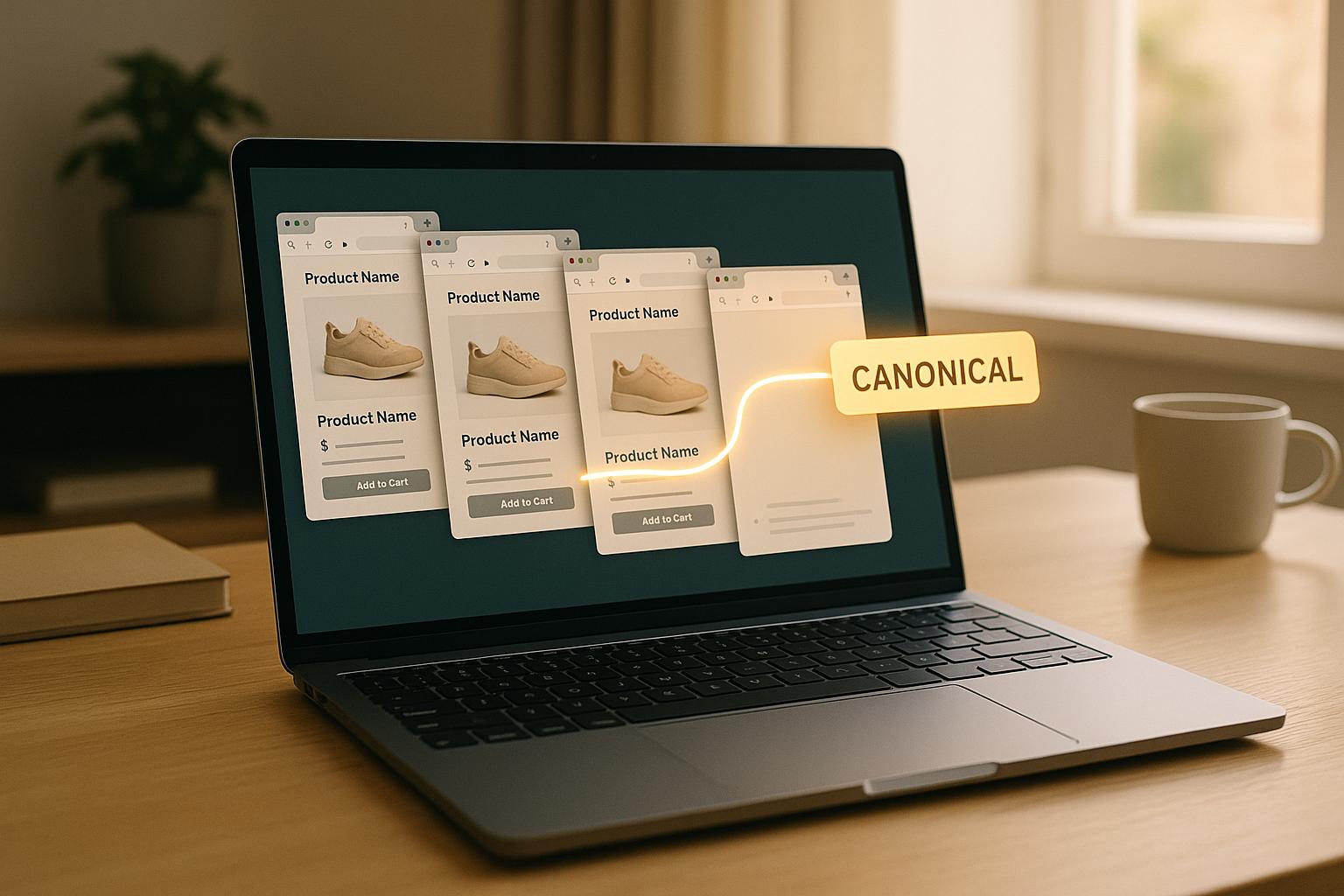When running an e-commerce website, duplicate content can hurt your SEO performance. Canonical tags help solve this by telling search engines which version of a page is the main one. For example, if your site creates multiple URLs for the same product (like /product?color=red and /product?color=blue), a canonical tag consolidates their ranking signals into one preferred URL.
Key Takeaways:
- What they do: Canonical tags consolidate duplicate URLs into one "main" URL for search engines.
- Why they matter: They prevent split rankings, wasted crawl budget, and keyword cannibalization.
- How to use them: Add
<link rel="canonical" href="https://example.com/page" />to duplicate pages. - Common issues: Avoid relative URLs, incorrect tag placement, and protocol mismatches.
Platforms like Shopify, WooCommerce, and Magento offer built-in tools for managing these tags. Regular audits using tools like Google Search Console can ensure your canonical tags work as intended. Fixing duplicate content with canonical tags can improve rankings and even boost organic traffic by up to 20%.
How Do Canonical Tags Work For Ecommerce Sites? – SearchEnginesHub.com
Duplicate Content Problems in E-commerce
E-commerce websites often face challenges with duplicate content, which arises when multiple URLs lead to similar or identical pages. This issue can significantly weaken SEO performance.
What Causes Duplicate Content
Several factors contribute to duplicate content in e-commerce:
- Dynamic URLs and filtering systems: Many platforms create unique URLs when customers filter products by attributes like color, size, price, or brand. For example, a single product might generate URLs like
/shoes?color=red&size=10&brand=nikeand/shoes?brand=nike&color=red&size=10, even though they display the same information. - Product variations: Separate pages are often created for each version of a product, such as different sizes or colors. These pages usually feature nearly identical content, differing only in minor details or images.
- Multiple category paths: A product listed in multiple categories can result in duplicate pages with different URLs. For instance,
/electronics/phones/iphone-15and/apple-products/phones/iphone-15might both display the same product. - Technical inconsistencies: Issues like HTTP vs. HTTPS, "www" vs. non-"www", trailing slashes, session IDs, and tracking parameters can lead to duplicate versions of the same page.
- Pagination and sorting options: When users sort or paginate category pages, the platform often generates new URLs for the same underlying content.
SEO Problems from Duplicate Content
Duplicate content creates several SEO challenges that can hurt e-commerce performance:
- Diluted ranking signals: Search engines have difficulty determining which version of the page should rank. Instead of consolidating ranking power into a single page, the authority is spread thin across duplicates, weakening overall performance.
- Split link equity: External links to different versions of duplicate pages divide their "link juice." For example, one site might link to the HTTP version, while another links to HTTPS. This fragmentation reduces the ranking potential of any single page.
- Search engine confusion: Google may index the wrong version of your page, such as a filtered URL with parameters instead of the primary product page. This can lead to unexpected filters or parameters being applied when visitors land on the page.
- Crawl budget waste: Search engines allocate a limited amount of time to crawling your site. Duplicate pages consume this budget, leaving less room for unique or updated content to be indexed. This can delay the discovery of new products or important updates.
- Keyword cannibalization: When multiple duplicate pages target the same search terms, they compete against each other in search rankings. Instead of one strong page ranking well, you end up with several weaker pages, reducing visibility across the board.
The financial consequences for e-commerce businesses can be severe. Poor search rankings mean fewer organic visitors, reduced product discovery, and lower sales. If duplicate pages bury your main product pages in search results, customers may struggle to find your offerings. Addressing these issues with solutions like canonical tags, which we’ll discuss in the next section, is critical for maintaining SEO health and maximizing visibility.
How to Set Up Canonical Tags
Setting up canonical tags involves pinpointing duplicate pages and implementing fixes to streamline your URL structure. This process includes both technical adjustments and ongoing checks to ensure your e-commerce site stays optimized.
Steps to Add Canonical Tags
Start by auditing your indexed pages using tools like Google Search Console. Use the URL Inspection tool to validate existing canonical tags. Pay close attention to areas where duplicates are common, such as:
- Product pages with different URL parameters
- Category pages with sorting or filtering options
- Pages accessible through multiple paths
Once you’ve identified duplicate groups, select the primary URL for each. For product pages, this is usually the main product URL without extra parameters. For category pages, pick the default view, avoiding sorting or pagination parameters.
The next step is the technical setup. Add the canonical tag to the HTML head of each duplicate page, pointing it to the chosen primary URL. The format looks like this:
<link rel="canonical" href="https://yourstore.com/canonical-page" />
On primary pages, include self-referencing canonical tags to reinforce their status as the preferred version.
After implementing the tags, submit your canonical URLs for indexing. Use the Index Coverage report in Google Search Console to check if Google acknowledges your preferences. Keep in mind that search engines may take a few weeks to fully process these changes.
Different e-commerce platforms have unique ways of handling canonical tags. Here’s how to approach them:
Platform-Specific Setup
Once you’ve added basic canonical tags, tailor them to your platform for better results.
Shopify
Shopify automatically generates canonical tags for most standard pages, including product and collection pages. However, for a more refined SEO strategy, you might need to adjust these tags. You can do this by editing your theme’s liquid templates. Locate the relevant template files (such as product.liquid or collection.liquid) and modify the canonical tags in the head section.
For stores with product variations, consider using apps like "Canonical URL Manager" or custom liquid code to manage complex setups. For example, ensure that variations like color or size point back to the main product page as the canonical URL.
Magento
Magento offers detailed control over canonical tags through its admin panel. Navigate to Stores > Configuration > Catalog > Search Engine Optimization to access these settings. Enable the options for "Use Canonical Link Meta Tag For Categories" and "Use Canonical Link Meta Tag For Products" to auto-generate canonical tags for these pages.
For advanced needs, you can modify XML layout files or create custom modules. This is especially useful for handling large catalogs with multiple filters or category assignments.
WooCommerce
WooCommerce uses WordPress’s built-in canonical tag functionality, which can be enhanced with plugins like Yoast SEO or RankMath. These plugins allow you to set custom canonical URLs for individual products and categories through an easy-to-use interface.
If your store has variable products, configure the canonical tags to point from individual variations back to the main product page. This avoids duplicate content issues when users access specific variations directly.
BigCommerce
BigCommerce automatically generates canonical tags for most pages. For customization, you’ll need to modify your theme templates or use apps. Access your theme files through the control panel to adjust the base templates for canonical tag implementation. While the platform handles basic needs, you may need custom solutions for more complex setups.
Regardless of your platform, always test your implementation. Use browser developer tools to inspect the HTML source and confirm that canonical tags appear correctly. Regularly monitor Google Search Console to ensure search engines are respecting your canonical preferences. Over time, this will help maintain a clean, optimized URL structure for your e-commerce site.
Best Practices and Mistakes to Avoid
Once your canonical tag setup is in place, fine-tuning it with the right strategies is essential. By following these best practices and steering clear of common errors, you can keep your SEO efforts on track.
Canonical Tag Best Practices
- Always use absolute URLs: Specify the full URL, including the domain and protocol, in your canonical tags. This eliminates any ambiguity for search engines about which page you’re referencing.
- Self-reference unique pages: Add self-referencing canonical tags to pages like product and category pages. This signals to search engines that these are the definitive versions.
- Point duplicates to the primary URL: Ensure all duplicate or similar pages reference the main URL. For example, if your main product page is
/products/widget-name, all variations should canonicalize to this URL. Consistency is key to avoiding duplicate content issues. - Conduct regular audits: After site updates, product launches, or migrations, review your canonical tags to confirm they’re accurate. Monthly checks can help catch any broken or misconfigured tags.
- Avoid canonical chains: Directly point to the primary URL instead of creating a chain of canonical tags. This prevents SEO value from being diluted.
Common Mistakes to Avoid
- Using relative URLs: Relative paths in canonical tags can confuse search engines, especially on sites with multiple subdomains or varied access paths. Stick to absolute URLs.
- Mishandling paginated content: Don’t canonicalize all pages in a paginated series to the first page. Instead, either use self-referencing canonicals for each page or implement pagination markup like
rel="next"andrel="prev". - Skipping updates after migrations: Failing to update canonical tags during site migrations can lead to broken links and wasted crawl budget. Include canonical adjustments in your migration checklist.
- Canonicalizing unrelated content: Avoid pointing a page with different content to another. For example, don’t canonicalize a red widget page to a blue widget page – they’re not duplicates.
- Mixing protocols: If your site uses HTTPS, ensure all canonical tags reference the HTTPS version. Mixing HTTP and HTTPS can cause technical issues.
- Overlooking mobile and desktop URLs: For sites with separate mobile and desktop versions, set up proper canonical relationships between them to avoid duplicate content problems.
Best Practices vs Common Mistakes
| Best Practice | Common Mistake | Effect |
|---|---|---|
| Use absolute URLs with domain and protocol | Use relative URLs or mix protocols | Search engines may misinterpret canonical targets |
| Self-reference unique pages | Leave unique pages without canonical tags | Missed opportunity to reinforce page authority |
| Point duplicates to a single primary URL | Create canonical chains or loops | Diluted SEO value and inefficient crawling |
| Audit tags after site changes | Use a "set-and-forget" approach | Broken tags and indexing issues |
| Canonicalize only true duplicates | Point different products to each other | User confusion and potential penalties |
| Update canonicals during migrations | Leave outdated URLs in canonical tags | Lost rankings and wasted crawl budget |
How to Track Canonical Tag Performance
Setting up canonical tags is just the first step; keeping an eye on their performance is crucial to avoid problems that could harm your search visibility.
Monitoring Canonical Tag Results
Once your canonical tags are in place, it’s essential to confirm that they’re working as expected. Google Search Console is your go-to tool for this. Use the URL Inspection tool to check which canonical URL Google has selected for each page. The Coverage and Pages reports can also help identify duplicate content or indexing issues. Pay attention to warnings like "Duplicate without user-selected canonical" or "Submitted URL not selected as canonical."
Here are some key metrics to track:
- Indexed pages: A reduction in duplicate pages signals effective canonicalization.
- Organic search rankings: Monitor rankings for the URLs you want prioritized.
- Organic traffic trends: Keep an eye on traffic to your canonicalized pages.
- Crawl budget efficiency: Fewer duplicates mean search engines can crawl your site more effectively.
Duplicate content is a widespread issue, affecting nearly 29% of the web, according to Moz. Poor canonicalization can dilute ranking signals, potentially causing a 15–20% drop in organic traffic.
Look for traffic changes in your analytics after implementing canonical tags. For example, one e-commerce site with thousands of product filter URLs saw a 20% boost in organic traffic and better keyword rankings within two months, as confirmed by Google Search Console data.
To stay ahead of potential issues, schedule regular audits using tools like Screaming Frog, Sitebulb, or SEMrush. These can help you catch and fix errors before they affect your rankings.
Fixing Canonical Tag Problems
If you notice problems during monitoring, it’s important to act quickly. Issues with canonical tags can lead to multiple versions of the same page appearing in search results, unexpected drops in rankings, or duplicate content warnings in Google Search Console.
One common issue is Google ignoring your canonical tags. This can happen if:
- The tags are placed outside the
<head>section. - You use relative URLs instead of absolute ones.
- The tags conflict with other signals, like 301 redirects to different URLs.
To prevent these issues, always maintain consistency in your internal linking. For example, if your canonical URL is /products/widget-name, avoid linking to /products/widget-name?color=red elsewhere on your site.
Server misconfigurations can also disrupt canonical tags. Ensure your canonical URLs are crawlable and don’t lead to 404 errors or redirect chains. Also, avoid using multiple canonical tags on the same page, as this can confuse search engines.
Protocol consistency is another critical factor. If your site uses HTTPS, make sure all canonical tags reference the HTTPS version. Mixing HTTP and HTTPS can cause technical conflicts that undermine canonicalization.
Focus on fixing high-traffic pages and key product categories first, and document your changes. Regular reviews are especially important after major updates like site migrations, product launches, or platform changes.
For more complex issues, consider professional SEO services like those offered by SearchX to fine-tune your technical setup and ensure your canonical tags perform as intended.
Conclusion
To wrap up, let’s revisit the importance of a solid canonical tag strategy for e-commerce SEO. Canonical tags play a key role in consolidating ranking signals from duplicate URLs. When your site has multiple URLs for the same or similar content – like product filters, variations, or parameterized URLs – canonical tags help search engines focus on the page you want to rank.
Using canonical tags effectively can lead to a potential 20% increase in organic traffic while improving the visibility of your product pages. By directing link equity to a single URL, you avoid splitting SEO value across duplicates. The good news? Implementing these tags doesn’t have to be complicated if you follow a structured approach.
Start by identifying duplicate content, choosing the main URL, and applying the rel=canonical tag to each variation. Many e-commerce platforms, such as Shopify and WooCommerce, have built-in tools to make this process easier.
But implementation isn’t a one-and-done deal. Regular checks through tools like Google Search Console can help you spot issues early, whether it’s search engines ignoring your canonical tags or new duplicate content popping up after site updates. Addressing common problems – like incorrect URLs, protocol mismatches, or errors in tag placement – can save you from significant traffic losses.
Accuracy is critical here. Use absolute URLs, keep internal linking consistent, and ensure that your canonical URLs are crawlable. For large e-commerce sites with thousands of product pages, these steps are even more important to maintain scalable growth.
If you’re just getting started, audit your site for duplicate content and prioritize adding canonical tags to your highest-traffic pages. For more complex setups, consulting a technical SEO expert can make a big difference. Companies like SearchX provide specialized e-commerce SEO services, from tailored platform solutions to in-depth technical audits, to help you get the most out of your site’s search performance.
FAQs
How do canonical tags help e-commerce websites stand out in search results?
Canonical tags play a crucial role for e-commerce websites, especially when it comes to handling duplicate content. They guide search engines by indicating which version of a page should take priority. For instance, if your online store features multiple product pages with slight differences – like variations in size or color – canonical tags ensure that search engines don’t dilute ranking signals across these similar pages.
By channeling link equity and directing authority to a single, preferred page, canonical tags strengthen search engine visibility. This helps the right page rank higher in search results. For large e-commerce platforms with extensive product catalogs, this approach is particularly valuable. It helps optimize crawl budgets, ensuring search engines focus on the most important content. In the competitive U.S. e-commerce landscape, implementing canonical tags effectively can significantly boost SEO efforts.
Why is it important to regularly review canonical tags on an e-commerce website?
Neglecting to review your canonical tags regularly can create SEO headaches, such as duplicate content issues. This can dilute your page authority and negatively impact your search rankings. Worse, incorrect tags might lead search engines to index outdated or irrelevant pages, which can frustrate users and result in traffic and sales declines.
Regular audits of your canonical tags can help you sidestep these problems. Ensuring your tags accurately point to the preferred versions of your pages keeps your SEO efforts on track and preserves a positive user experience.
How can e-commerce businesses manage canonical tags effectively on platforms like Shopify, WooCommerce, and Magento?
Managing canonical tags on platforms like Shopify, WooCommerce, and Magento can seem tricky, but their built-in tools make it manageable with the right approach.
Shopify, for instance, automatically adds canonical tags to most product pages. However, for situations like paginated content or duplicate pages, you might need to step in. This could involve editing your theme code or using metafields to fine-tune the tags.
For WooCommerce and Magento, things are a bit more hands-on. These platforms often require you to tweak theme files or adjust settings in SEO plugins to set canonical tags correctly. The main objective is to ensure all tags direct search engines to the preferred version of a page.
When done right, canonical tags help search engines focus on the most relevant content, reducing duplicate content issues, enhancing user experience, and even improving your search rankings. It’s a small step that can make a big difference.




